#Athenian Acropolis
Text
Check out "Up Close: The Archaeology of the Athenian Acropolis," another of my remote teaching videos. Now on YouTube, free for all.
It's a fun and educational tour of the monument
youtube
#Youtube#archaeology#ancient history#history#Athens#Acropolis#Athenian Acropolis#Parthenon#Ancient Greece
5 notes
·
View notes
Text
Halloween costume for me and the girls:
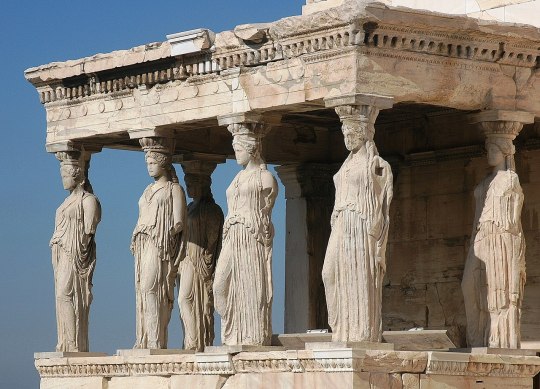
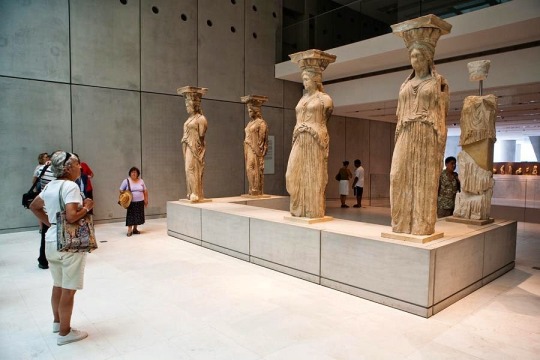
#caryatid#greek architecture#to be spiteful to the british museum it should be the five with a missing poster for the sixth or something#halloween#halloween costume#whats more tragic than being separated from your sister after thousands of years together#fuck the british museum#acropolis caryatids#athenian acropolis
5 notes
·
View notes
Text
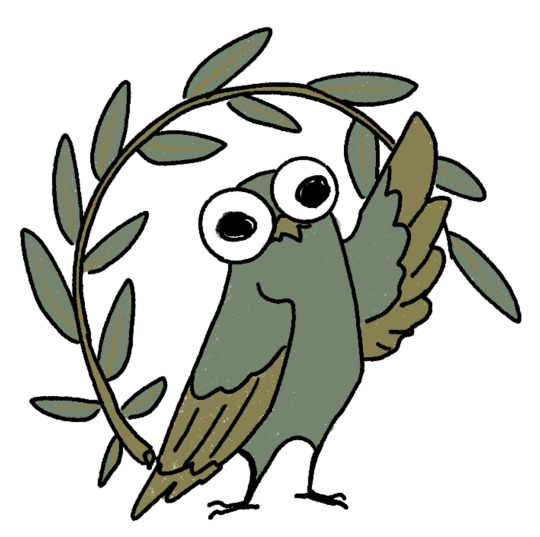
I drew a lil athenian owl since i was lucky egnough to visit this week!
#owl#athena#athenian owl#greek mythology#ancient greek#one thing that realy pissed me of when visiting th is that most of the stuff in the acropolis museum was plaster casts#the originals are in the *fucking british museum*#* and some pillars from sunion are in some ritch wankers garden with his bust ontop of them
6 notes
·
View notes
Text

ATHENA
“I begin to sing of Pallas Athena, the glorious goddess, bright-eyed, inventive, unbending of heart, pure virgin, saviour of cities, courageous, Tritogeneia. Wise Zeus himself bare her from his awful head, arrayed in warlike arms of flashing gold, and awe seized all the gods as they gazed. But Athena sprang quickly from the immortal head and stood before Zeus who holds the aegis, shaking a sharp spear: great Olympus began to reel horribly at the might of the bright-eyed goddess…” (-Homeric Hymn, translated by H.G. Evelyn white)
ATHENA (uh-THEE-na) , the virgin goddess of wisdom, war, strategy, defense, city state building and crafts like pottery, and patron goddess of Athens. In my Illustration she towers above Athens, as the city's patron and eternal defender.
She was born from Zues' head fully armed, and wears upon her chest plate armor the infamous Aegis, with medusa's head, (sometimes depicted as a shield) which is used as a protective amulet and was said to let out a terrible roar in battle. Upon her shield is a horse and rider wearing a bridle, which Athena invented for mortals to ride and control horses (along with chariots and wagons).
Upon her arm is her sacred animal, the owl, with its night vision, having the ability to see things that others cannot, hence it being a symbol of wisdom. The snake at her feet represents the early Athenian ruler, Erichthonius, whose symbol was the snake. He is represented below the statue of Athena in the Parthenon as the snake hidden behind her shield. The most sacred building on the Acropolis of Athens, the Erechtheum, is dedicated to Erichthonius.
Support my book kickstarter "Lockett Illustrated: Greek Gods and Heroes" coming in early 2024.
Linktree:https://tr.ee/DcjSQDSEv3
#pagan#hellenism#greek mythology#tagamemnon#mythology tag#percyjackson#dark academia#greek#greekmyths#classical literature#percy jackon and the olympians#pjo#homer#iliad#classics#mythologyart#art#artists on tumblr#odyssey#literature#ancientworld#ancienthistory#ancient civilizations#ancientgreece#olympians#greekgods#agamemnon#troy#trojanwar
595 notes
·
View notes
Text











Athenian Architecture
The Antiquities of Athens by Scottish archaeologist James "Athenian" Stuart (1713-1788) and British architect Nicholas Revett (1720-1804), originally published 1762-1830, contains five volumes. Printed in London by German-born John Haberkorn, this was to be his best-known work.
James Stuart and his friend Nicholas Revett embarked on a journey to Greece in 1751. Their mission was to record and measure antiquities, a task no one had accurately accomplished before. Despite facing numerous challenges, including threats from Turkish gangs, their unwavering dedication led to the first accurate survey of ancient Greek architecture completed between 1751 and 1754.
The illustrations in the volumes are not merely decorative; they consist of meticulously etched and engraved plates featuring buildings, maps, plans, and friezes. These illustrations are instrumental in providing a comprehensive visual survey of ancient Greek architecture, allowing readers to appreciate the precision and scale of the antiquities documented.
The particular building featured here is the Choragic Monument of Lysicrates, commonly called the Lanthorn of Demosthenes. It was built around 334 BCE and is the only surviving example of a choragic monument. This monument is situated near the eastern end of the Acropolis, one of Athens's most significant archaeological sites. In ancient Greece, a choragus was a wealthy citizen who financed a production at one of the city's festivals. The monument was originally surmounted by a bronze tripod commemorating Lysicrates’ sponsorship of the chorus that had won first prize at the City Dionysia festival.
Stuart and Revett were the first to recognize the story depicted on the frieze. It is the story of Dionysus, the god of wine and revelry, and the Tyrrhenian pirates. In the Hymn to Dionysus in the Homeric Hymns, the god is kidnapped by pirates who fail to recognize him as a god. The pirates attempt to bind him but are unsuccessful. Instead, Dionysus drives them to jump overboard. Once they’re in the water, he uses his divine gifts to turn them into dolphins, as illustrated here in the depictions of the monument's friezes.
View another post from The Antiquities of Athens.
View other Classics posts.
-- Melissa, Special Collections Undergraduate Classics Intern
#Classics#athens#greece#The Antiquities of Athens#Choragic Monument of Lysicrates#James “Athenian” Stuart#Nicholas Revett#greek mythology#greek revival#greek gods#greek architecture#greek archaeology#architecture#choragus#dionysus#baccus#pirates#mythology#ancient greek#ancient greece#ancient history#Hymn to Dionysus#homeric hymns#frieze#lysicrates#festivals#Dionysia
65 notes
·
View notes
Text

"Roman Pentelic Marble Statue of a Sleeping Maenad (117-138 AD); lying on a panther skin spread on a rocky surface; type in known as reclining Hermaphrodite. It was found at south of Athenian Acropolis, Greece."
38 notes
·
View notes
Text

Oil lamp in shape of a greek warship, end of the 5th cent. BC
The oil lamp with the inscription ΙΕΡΟΝ ΤΗΣ ΑΘΗΝΑΣ (Sanctuary of Athena) was discovered inside the Erechtheion, Acropolis. Its form is linked to the celebration of the Panathenaia and the worship of Athena Polias, whose wooden cultic statue (xoanon) was kept in the eastern part of the Erechtheion.
During the last day of the celebration, the Athenians offered to the xoanon a new peplos, which, after the victory at Salamis, was transported hung like a sail on the mast of a warship -most possibly on one of the victorious triremes of the naval battle– which moved on wheels. The lamp possibly reproduces the features of this ship.
193 notes
·
View notes
Text

Louis Kontoulis, guitarist/vocalist of the (possibly) first Greek punk band Stress, captured here as a 16-year-old back in 1979 in the neighbourhood of Plaka, "a wonderful Babel" as he remembers the district under the Acropolis where nightclubs, discos, rock and gay bars were once located, a melting pot that attracted junkies, beggars, prostitutes, tourists and bar-hoppers and acted as a melting pot for the various youth subcultures of the time and as home of the burgeoning Athenian punk scene in the late-‘70s/early-'80s.
(via & via)
34 notes
·
View notes
Text
Panathenaia
~ 23-30 Hekatombaion~
Meaning 'All-Athenian', Panathenaia celebrated Athena as the patroness of Athens. It was the premier festival of the year, sparking large celebration. Two versions of this festival took place, Panathenaia ta mirka (Lesser Panathenaia) and Panathenaia ta megala (Greater Panathenaia). Greater Panathenaia took place every four years compared to its annual counterpart. The only difference in festivals was that of scale and performance, with Greater Panathenaia marking the greater festival.

Part of the name sake of the month, Panathenaia based with a hecatomb throughout. Processions took place outside of Acropolis, a means to show the new peplos for Athena's statue. This weaving of the new fabric was held at Plynteria. The traditional blue and yellow would be taken to Athena in a ship. Everybody took part.
Kanephoroi (young women with baskets on their heads containing grain), Diphrophoroi (young girls carrying chairs), Thallophoroi (Old men bearing branches and young men in purple robe, and non-citizens proceeded to Athena's temple. Non-citizens often held cakes and honeycomb while freed slaves and non-Greeks carried oak branches. Daughters of Metics carried water jugs. Representatives of City-States throughout Attica brought armor and cows as offerings. The victors of the games were included in the procession.

The procession walked throughout many Attican cities most notably, Eleusinium, Acropolis and Propylaea where they ended. Sacrifices were completed with prayers. Sacrifices included several epithets of Athena including Athena Hygiaea, Athena Polias and Athena Nike. Each epithet was given something different.
Part of the festival highlighted the Panathenaian Games, similar to its Olympiad counterpart. The games held torch races to determine sacrificial fire, all-night service and meat meals for anyone, all at the city's pocket.
While the early games were for Athenians only, in 566 BCE the games were open to all Greeks. This was part of Panathenaia ta megala. In the annual festival Athenian-Only games persisted, the Greater festival offered the opportunity for others to join.

Later, musical competitions and recitations of Homer were added. The Iliad and Odyssey were popular choices as well as short-length poetry. Foot-racing, pentathlon, wrestling, gymnastics, boxing and pankration were observed in three male "age" categories: older men, younger men and boys. Chariot races were also added along with javelin-throwing from horseback and races for foals and full-grown horses.
Winners of the games were prized olive oil from Athena's sacred olive tree along with money depending of rank of winning.
Traditional Offerings:
Beef
Olives and Olive oil
Water or khernips
Oak branches/leaves
Hymns to Athena
Traditional Acts:
Games, such as running, horse racing and torch racing
Hymns and Offerings to Athena
Reciting or reading poetry, such as Homer
Wearing purple, yellow or blue
feasting with community
Khaire Athena! Happy Panathenaia! 🦉🏅🍃
#hellenic polytheism#hellenic witch#hellenism#hellenic deities#hellenic polytheistic#hellenic worship#theoi#hellenistic#helpol#athena deity#athena#hellenic pantheon#panathanaia
24 notes
·
View notes
Text
Summer Solstice Deities and Festivities
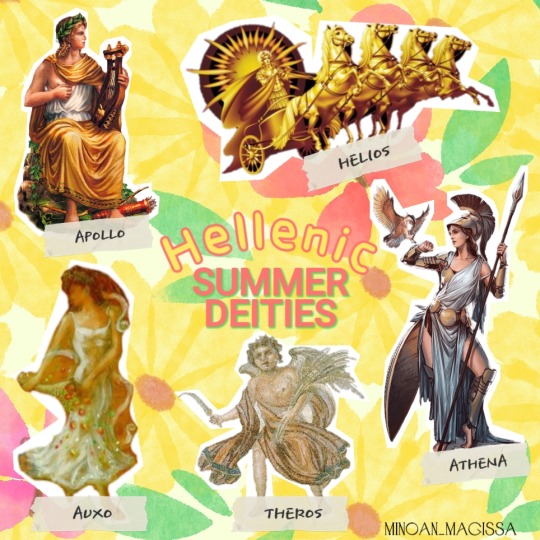
Summer Solstice/Καλοκαίρι/Θέρος/ Litha Blessings to my Northern Hemisphere friends! 🌞
Today also happens to be Arrephoria (Ἀρρηφόρια), a festival in honour of Athena. More on that later in the post!

Some info about the summer-related deities in the graphic:
☀️Auxo (Αὔξω) is one of the Horae (Ὧραι), and the goddess and personification of summer. She is also a protectoress of vegetation, growth, and fertility.
☀️Theros (Θέρος) is another personification of summer and is usually depicted as a winged boy holding an ear of grain in one hand and a sickle in the other. Theros is the word for summer in Ancient Greek.
☀️Athena (Ἀθηνᾶ) is the Olympian goddess of wisdom and warfare. Her main festival is the Panathenaia, which was celebrated during Hekatombaion in midsummer. The solstice also starts off with Arrephoria. Sinoika is yet another celebration during the summertime that honours her.
☀️Apollo (Ἀπόλλων) is the Olympian god of sunlight, healing, music, and poetry.
☀️Helios ( Ἥλιος) is the Titan god and personification of the sun. He is also the god of eyesight and oaths.
What I Did Today

I decorated my altar for the solstice and featured summer deities on the center of it.

I ate a (mostly) Mediterranean meal outside in the sunshine: kalamata olive spread, anaheim peppers, & extra virgin olive oil on gluten-free toast, gigantes beans with feta, and Persian cucumbers sprinkled with Greek oregano and paprika. 😋
I also did a lot of research to put together this post. That honestly took up most of my day. 😆
And now onward to Arrephoria!

Arrephoria (Ἀρρηφόρια) stems from the words "ἀρρητον" (mystery) and "φέρω" (I carry/bring). It is a midsummer fertility festival that honours Athena and takes place on the first day of the Estival Solstice.

In Ancient Athens, two young girls from aristocratic families were elected to reside as arrephoroi (άρρήφοροι: virgin acolytes of Athena Polias) at the Arrephorion on the Acropolis for a year at a time. Their main responsibilities included maintaining Athena's sacred olive tree and with the aid of other women, weaving Athena's new peplos.

On the evening of Arrephoria, the girls donned in white clothing placed what Athena's priestess gave them (a mystery item in closed chests) atop their heads. Then, they both carried the chests down (without looking at the items) to the temenos (τέμενος: holy grove) of Aphrodite via a concealed stairway inside the north wall and proceeded to carry something else (possibly dew from the spring) back up to the Acropolis.
With Hekatombaion (the 1st is the Athenian New Year) around the corner, Arrephoria also served as a "tying up" of the old year, ensuring nothing was carried over into the new one.
What you can do for Arrephoria:
📑finish any unfinished projects
👕declutter (i.e. donate clothing you no longer need)
🧹if you didn't clean your altar(s) for Kallynteria, now is the time to do it
💧pour a libation of dew or water for Athena
🍱have a hearty feast and offer some to Athena
*Kallynteria and Plynteria were two rituals that prepared for Arrhephoria.
The myth the ritual itself is based on:
Kekrops (Κέκροψ), the first mythical king of Athens, had three daughters named Aglauros (Ἄγλαυρος), Erse (Ἕρση), and Pandrosos (Πάνδροσος) - each name referring to dew. One night, Athena gave them a closed basket. While she forbade them to open it, Aglauros' and Herse's curiosity got the better of them, so they took a peek, only to see a baby (Ericthonios, Hephaestus' mysterious son).

Seeing as they broke her trust, Athena punished them by making snakes appear out of the basket, merely to scare them. Startled, the two girls jumped off the Acropolis and met their untimely demise.

Pandrosos didn't partake and was spared. Eventually, a shrine was errected in her name (located next to the sacred olive tree). Therefore, on Arrephoria, Pandrosos (in addition to Athena) were commemorated, and the two arrephoroi fulfilled the unfinished duty of the other two.
Sources: "Girls and Women in Classical Greek Religion" by Matthew Dillon, Hellenion.com: Arrephoria, Archaeology.org: Acropolis Arrephorion Restoration
#summer solstice#summer#midsummer#litha#arrephoria#athena#ancient athens#hellenic polytheist#hellenic pagan#hellenic polytheism#hellenic religion#greek mythology#hellenismos#ancient greece#theros#athena devotee#athena devotion#Spotify
166 notes
·
View notes
Photo

This beautiful statue of Athena, the Greek goddess of wisdom, was taken from the Athenian Acropolis. (circa 525-520 B.C.).
567 notes
·
View notes
Text
The people of Athens also associated the goddess Peithō with Aphrodite, chiefly with respect to Aphrodite’s civic function as exemplified in her epithet Pandēmos, which means the goddess who “belongs to all the people”. As an epithet or cult title, Pandēmos seems to have no Near Eastern parallel and instead appears distinctively related to the Athenian polis. Pausanias, the Greek travel writer, notes that Aphrodite and Peithō shared a cult site of great antiquity and importance on the southwest slope of the Athenian Acropolis, where extant archaeological remains seem to confirm his observations. In cult, art and literature, the alliance of these two goddesses, Aphrodite Pandēmos and Peithō, symbolizes the concepts of unification and harmony in all of their public and private expressions. While Athenian statesmen might seek the joint endorsement of Aphrodite Pandēmos and Peithō to help unite opposing factions into political concord, yearning lovers or prospective brides would also look to these two beneficial and diligent goddesses to initiate erotic fusions and then shower their conjugal unions with blessings. Peithō is often understood as an epithet of Aphrodite herself, and sometimes the name is used to describe this specific aspect of Aphrodite’s divine power to persuade, merge and unify.
Aphrodite by Monica S. Cyrino, from Routledge's Gods and Heroes of the Ancient World series
13 notes
·
View notes
Text




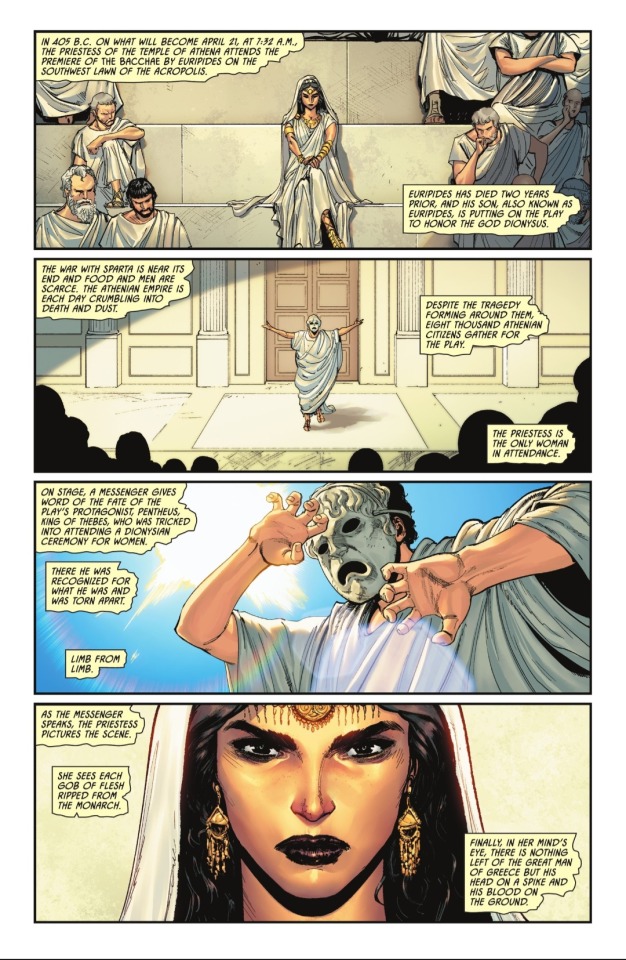





"In 405 b.C. On what will become April 21, at 7:32 A.M., the priestess of the temple of Athena attends the premiere of the Bacchae by Euripides on the southwest lawn of the Acropolis. Euripides has died two years prior, and his son, also known as Euripides, is putting on the play to honor the god Dionysus. The war with Sparta is near its end and food and men are scarce. The athenian empire is each day crumbling into death and dust. Despite the tragedy forming around them, eight thousand athenian citizens gather for the play."
Batman: Killing Time (2022).
#dc comics#batman#bruce wayne#the riddler#edward nygma#catwoman#selina kyle#the penguin#oswald cobblepot#jim gordon#batman killing time
24 notes
·
View notes
Text
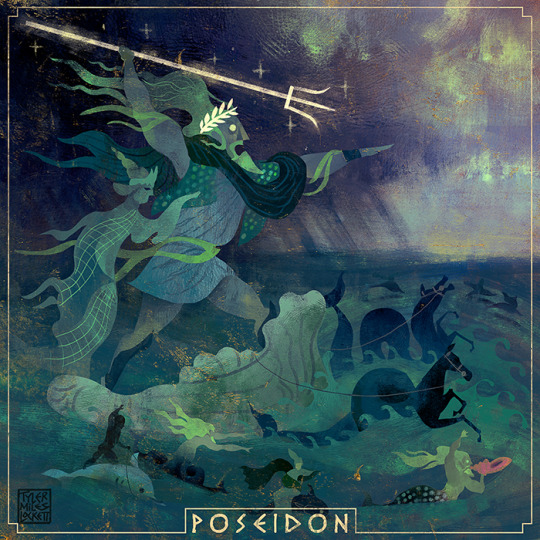
POSEIDON
“I begin to sing about Poseidon, the great god, mover of the earth and fruitless sea, god of the deep who is also lord of Helicon and wide Aegae. A two-fold office the gods allotted you, O Shaker of the Earth, to be a tamer of horses and a saviour of ships!”
(-Homeric Hymn, translated by H.G. Evelyn white)
POSEIDON(puh-SAI-din) is the God of the seas, earthquakes, droughts, and horses. Pulled along in his seashell chariot by half-horse, half-fish creatures called Hippocampi, he holds his sacred trident high, bringing a tumultuous storm behind him. Standing beside him is his sea nymph wife, Amphitrite, who is the eldest of fifty nereid daughters of Nereus; the “old man of the sea.”
Amongst the waters are the god’s faithful followers. The half-fish, half-man creature at bottom right is Triton, herald son of Poseidon, who uses a conch shell to calm the waves and announce the God’s arrival. In the middle is a Nereid, a female sea nymph, typically portrayed as a maiden riding a dolphin. Bottom left is Palaimon, sea god and protector of sailors, sometimes depicted as a boy on a dolphin.
The god of the sea is known for his savage retributions. One fascinating episode involves Poseidon and Athena entering a competition to become the patron god of Athens. Upon the Acropolis, Poseidon produces a salt water spring for the Athenians, while Athena wins by creating the first olive tree. The sea god, in his anger, sends a flood to punish the mortals. In the odyssey, after Odysseus blinds Poseidon’s son, the giant cyclops Polyphemus, the god causes havoc and disaster for the hero and his crew as they attempt to sail home. Poseidon sends Cetusthe sea serpent to punish QueenCassiopa for her hubris in comparing her daughter Andromedato the nereids. And, he sends a bull from the sea to terrorize Theseus’ son Hippolytus’ chariot.
Want to own my Illustrated Greek myth book jam packed with over 130 illustrations like this? Support my book kickstarter "Lockett Illustrated: Greek Gods and Heroes" coming in early 2024. check my bio LINKTREE
Thanks for looking and reading! :)
#pagan#hellenism#greek mythology#tagamemnon#mythology tag#percyjackson#dark academia#greek#greekmyths#classical literature#percy jackon and the olympians#pjo#homer#iliad#classics#mythologyart#art#artists on tumblr#odyssey#literature#ancientworld#ancienthistory#ancient civilizations#ancientgreece#olympians#greekgods#agamemnon#troy#trojanwar
238 notes
·
View notes
Text

tumblr is now advertising the Athenian acropolis to me in Spanish?
edit its Italian not Spanish I can't tell the difference between European languages
8 notes
·
View notes
Text
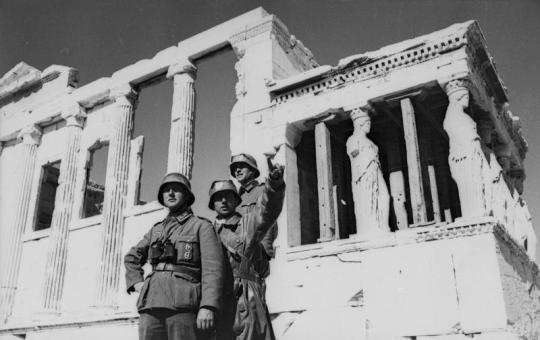
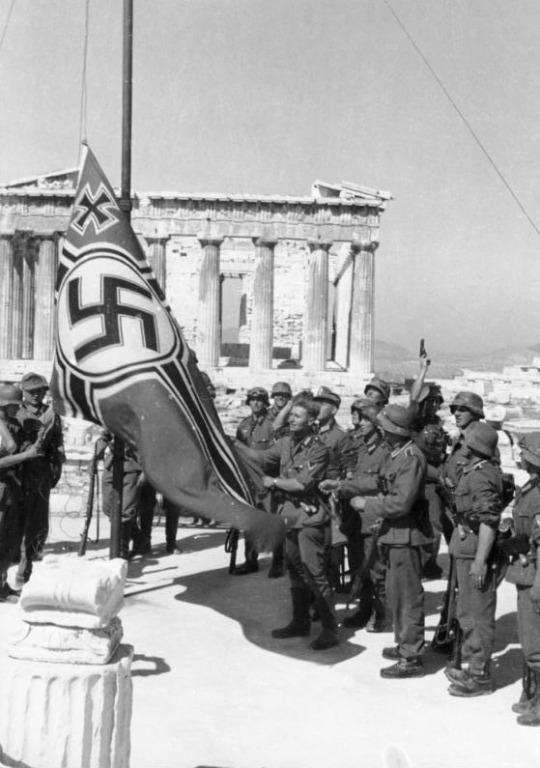
Nazis on the Athenian Acropolis during World War II.
When the Germans took over Greece in 1941, they were especially eager to claim the Acropolis. Hitler was obsessed with Greek and Roman culture, seeing it as the opposite of the “degenerate” modern art that he loathed. To possess the Acropolis, the most important symbol of Greek antiquity, was no small thing for the Nazis. They made sure to raise their flag high over the Acropolis... until two university students snuck onto the Acropolis and tore the flag down.
Read the whole piece here:
146 notes
·
View notes